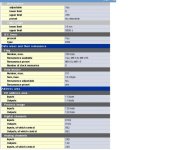Hi All
I am currently working on a project using the CPU above. I haven't worked with Step 7 before so I'm working it out as I go on.
I have configured the HW with the following components.
313C-2DP using the following via profibus
Accopus Drive x 4
Wago Distributed I/O x 5
This has automatically assigned the following addreses.
Each Accopus drive requires 32 bytes input and 32 bytes output, I will only use the first 4 bytes of both though.
Step 7 has assigned the following
Accopus Drive 1 - Byte 2-33
Accopus Drive 2 - Byte 34-65
Accopus Drive 3 - Byte 66-97
Accopus Drive 4 - Byte 128-159
Now when I click on each of the drives in HW config I can open them up and see the individual I/O Bits on the first three drives as they are listed as Bool. My question is that the 4 drive is only listed in Bytes. Can I still address individual Bits on a Byte on this drive, if so how do I address them.
I hope you can understand the question and also have an answer.
Steve
I am currently working on a project using the CPU above. I haven't worked with Step 7 before so I'm working it out as I go on.
I have configured the HW with the following components.
313C-2DP using the following via profibus
Accopus Drive x 4
Wago Distributed I/O x 5
This has automatically assigned the following addreses.
Each Accopus drive requires 32 bytes input and 32 bytes output, I will only use the first 4 bytes of both though.
Step 7 has assigned the following
Accopus Drive 1 - Byte 2-33
Accopus Drive 2 - Byte 34-65
Accopus Drive 3 - Byte 66-97
Accopus Drive 4 - Byte 128-159
Now when I click on each of the drives in HW config I can open them up and see the individual I/O Bits on the first three drives as they are listed as Bool. My question is that the 4 drive is only listed in Bytes. Can I still address individual Bits on a Byte on this drive, if so how do I address them.
I hope you can understand the question and also have an answer.
Steve




